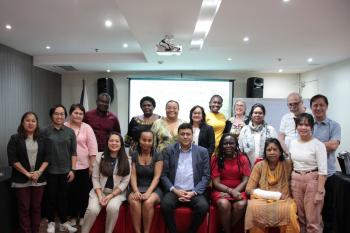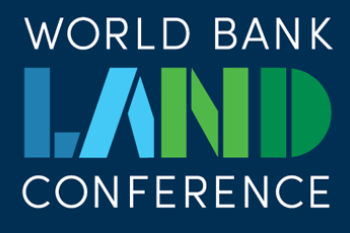Experts reach important consensus on land indicator 1 4 2
First published here on 13 June 2017 on www.UNHABITAT.org
A group of statisticians and property rights experts recently met at the World Bank offices in Washington D.C., with the objective of developing the preparatory requirements for supporting the reclassification of the Sustainable Development Goal Indicator 1.4.2 from Tier III to Tier II status.
Indicator 1.4.2 – or the “Land Indicator” as it is colloquially referred to in the land rights community – measures the “proportion of total adult population with secure tenure rights to land, with legally recognized documentation and who perceive their rights to land as secure, by sex and by type of tenure.” It is just one of 240+ indicators that were proposed to monitor the implementation of the Sustainable Development Goals. Tenure security indicator 1.4.2 is considered by the land community, including policymakers, development professionals and donors as a crucial indicator for tracking progress on tenure security issues for all, with legally documented and perceived tenure rights.
After a series of intense discussions and negotiations, the group achieved an important step in this direction, by agreeing on a set of household survey questions that will be included in the global and national-level surveys and censuses to measure just how secure peoples’ land and property rights are. This agreement will help custodian agencies of this indicator make the argument this October at the Inter-Agency Expert Group meeting on the SDGs that Indicator 1.4.2 deserves to be reclassified from Tier III status, where it is in danger of being dropped from the SDG agenda to a safer Tier II status that would allow countries to start the global investments in the data collection of monitoring security of tenure. This is one of a series of expert group consultative meetings hosted by the custodian agencies for 1.4.2 to ensure wider consultation with National Statistical Organizations and other stakeholders in the development of a methodology for measuring the progress of this indicator.
Importance of re-classifying the ‘Land Indicator’ from Tier III to Tier II
The agreed questions are:
- How likely are you to lose your land/ property or use right in the next 5 years?
- Do you have the right to exclusively or jointly bequeath your land/ property?
- Do you have property/ tenure rights over this land/property or another property? If so, what type of rights?
- Do you have documentation of the tenure/ property rights on this property and/ or another property?
- What is the type of documentation over the land/ property?
- Whose name is on the document and can you show the document?
Currently, little data exists on the proportion of the adult population with secure rights to land. According to estimates, two billion people worldwide may be tenure insecure, and for some regions such as Africa, 90 percent of the continent’s land is unregistered. But, despite some scattered initiatives, tenure security – both in terms of legal documentation and in terms of peoples’ perceptions of how secure their rights are – has never been systematically monitored or measured. Yet, this figure is critical for policymakers to understand, given the inextricable link between securing property rights and ending poverty and inequality.
At present, Indicator 1.4.2 is classified, along with over 80+ other indicators, in the lowest Tier of SDG indicators. This classification – Tier III – is reserved for indicators whose globally agreed methodology and conceptual clarity for collecting the necessary data is not yet clear. As a result, no data is being collected for any of the Tier III indicators. The agreement on household survey questions to support monitoring of indicator 1.4.2 is an important step towards reaching consensus on methodology, which in turn should help the argument for the need to re-classify this indicator from Tier III to II status. During the meeting, it also emerged that quite a number of countries have collected data on land related issues as part of national surveys, previous efforts by the land experts and global donors support to land sustainable governance initiatives.
The household survey questions, the exact wording of which will be refined over the coming months, measure both the presence of legally recognized land documentation and peoples’ perceptions of their land tenure security.
Steps to follow and role of custodian agencies
The agreement on a set of core household survey questions satisfies an important pre-requisite for reclassification in October, but there are several additional steps to be taken before 1.4.2 can get over the hurdle.
First, experts must agree on the administrative data that National land agencies will need to supply to satisfy the ‘legal documentation’ component of the indicator. For that, another Expert Group Meeting will be held on July 6 and 7, in Barcelona. There are on-going efforts by the custodian agencies which include recommendations made earlier by experts from the Global Land Indicators Initiative (GLII) encouraging harmonization of data collection for indicator 1.4.2 and that of land Indicator 5.a.1, which measures land tenure security over agricultural land, and feeds into SDG Goal 5, on women’s empowerment. This topic is under discussion by the custodian agencies and will further be discussed during an Expert Group Meeting on Women’s Land Rights planned for July 8-10, in New York.
UN Habitat and the World Bank, two agencies tasked by IAEG-SDGs as custodians of indicator 1.4.2, are required to gather results from national surveys and pilots conducted by NSOs, taking into account regional representation of the results to demonstrate that the proposed methodology for measuring this indicator has been tested. National surveys have included similar questions in their previous work which will also be considered. These results will be presented to the IAEG-SDGs meeting in October, to show that collecting 1.4.2 data is feasible and already being implemented by a core set of countries. Questions on land documentation and perceptions of tenure security have already been asked in the course of several past and ongoing surveys, including World Bank’s LSMS surveys, UN Habitat-led urban inequities surveys and other specialized land survey pilots, impact evaluations of USAID and Millennium Challenge Corporation land governance programs, global surveys like DHS, PRIndex, MICS, and others. The Custodians will have to gather relevant data from these surveys and curate them in partnership with National Statistics Offices.
Finally, the custodian agencies are required to improve the metadata document for 1.4.2 to take into account key decisions and inputs from experts’ consultations addressing key areas like definitions, data collection methodologies, and proposed sources for collecting the needed data going forward.
All of these elements will be combined in a request for reclassification document that will be submitted to the IAEG-SDG by the custodian agencies during the month of September 2017. The Global Land Indicators Initiative, hosted and facilitated by GLTN in UN Habitat, remains an important support for the efforts of the custodian agencies and indicators in the SDGs; while advancing global coordination for land governance monitoring which takes into account other frameworks like VGGTs, Framework and Guidelines on Land Policy in Africa and CSOs initiatives.
The Washington meeting showed that the road to reclassification is feasible but challenging. Much work remains to be completed, and time is tight between now and October, when reclassification decisions will be made by the IAEG-SDGs. Yet, achieving consensus on the critical point of household survey questions showed that with strong stakeholder support, securing the tenure security indicator in the SDGs monitoring framework can move forward, hopefully towards a positive outcome this fall.


